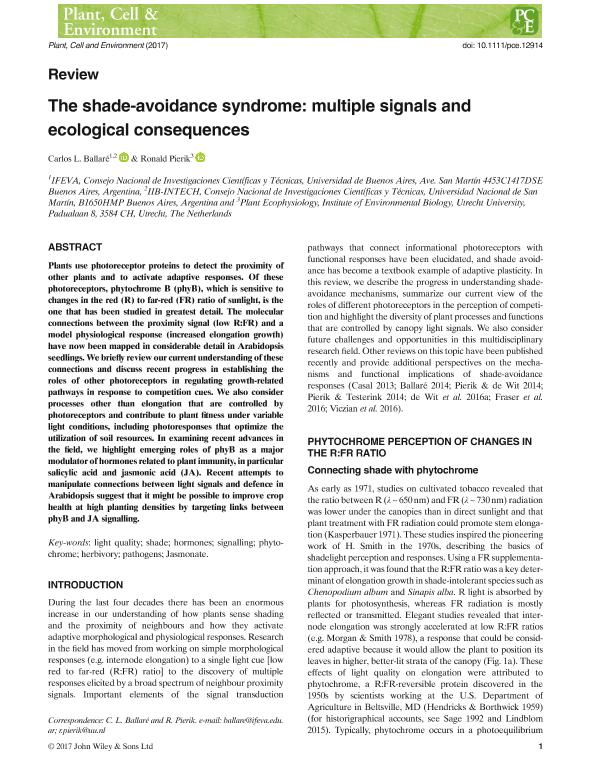Mostrar el registro sencillo del ítem
dc.contributor.author
Ballare, Carlos Luis

dc.contributor.author
Pierik, Ronald

dc.date.available
2017-07-13T20:01:05Z
dc.date.issued
2017-01
dc.identifier.citation
Ballare, Carlos Luis; Pierik, Ronald; The shade-avoidance syndrome: Multiple signals and ecological consequences; Wiley Blackwell Publishing, Inc; Plant, Cell and Environment; 1-2017
dc.identifier.issn
0140-7791
dc.identifier.uri
http://hdl.handle.net/11336/20407
dc.description.abstract
Plants use photoreceptor proteins to detect the proximity of other plants and to activate adaptive responses. Of these photoreceptors, phytochrome B (phyB), which is sensitive to changes in the red (R) to far-red (FR) ratio of sunlight, is the one that has been studied in greatest detail. The molecular connections between the proximity signal (low R:FR) and a model physiological response (increased elongation growth) have now been mapped in considerable detail in Arabidopsis seedlings. We briefly review our current understanding of these connections and discuss recent progress in establishing the roles of other photoreceptors in regulating growth-related pathways in response to competition cues. We also consider processes other than elongation that are controlled by photoreceptors and contribute to plant fitness under variable light conditions, including photoresponses that optimize the utilization of soil resources. In examining recent advances in the field, we highlight emerging roles of phyB as a major modulator of hormones related to plant immunity, in particular salicylic acid and jasmonic acid (JA). Recent attempts to manipulate connections between light signals and defence in Arabidopsis suggest that it might be possible to improve crop health at high planting densities by targeting links between phyB and JA signalling.
dc.format
application/pdf
dc.language.iso
eng
dc.publisher
Wiley Blackwell Publishing, Inc

dc.rights
info:eu-repo/semantics/openAccess
dc.rights.uri
https://creativecommons.org/licenses/by-nc-sa/2.5/ar/
dc.subject
Herbivory
dc.subject
Hormones
dc.subject
Jasmonate
dc.subject
Light Quality
dc.subject
Pathogens
dc.subject
Phytochrome
dc.subject
Shade
dc.subject
Signalling
dc.subject.classification
Ciencias de las Plantas, Botánica

dc.subject.classification
Ciencias Biológicas

dc.subject.classification
CIENCIAS NATURALES Y EXACTAS

dc.title
The shade-avoidance syndrome: Multiple signals and ecological consequences
dc.type
info:eu-repo/semantics/article
dc.type
info:ar-repo/semantics/artículo
dc.type
info:eu-repo/semantics/publishedVersion
dc.date.updated
2017-07-13T18:17:47Z
dc.journal.pais
Reino Unido

dc.description.fil
Fil: Ballare, Carlos Luis. Consejo Nacional de Investigaciones Científicas y Técnicas. Oficina de Coordinación Administrativa Parque Centenario. Instituto de Investigaciones Fisiológicas y Ecológicas Vinculadas a la Agricultura. Universidad de Buenos Aires. Facultad de Agronomía. Instituto de Investigaciones Fisiológicas y Ecológicas Vinculadas a la Agricultura; Argentina. Consejo Nacional de Investigaciones Científicas y Técnicas. Centro Científico Tecnológico Conicet - La Plata. Instituto de Investigaciones Biotecnológicas. Universidad Nacional de San Martín. Instituto de Investigaciones Biotecnológicas; Argentina
dc.description.fil
Fil: Pierik, Ronald. Utrecht University; Países Bajos
dc.journal.title
Plant, Cell and Environment

dc.relation.alternativeid
info:eu-repo/semantics/altIdentifier/doi/http://dx.doi.org/10.1111/pce.12914
dc.relation.alternativeid
info:eu-repo/semantics/altIdentifier/url/http://onlinelibrary.wiley.com/doi/10.1111/pce.12914/abstract
Archivos asociados
